I haven’t worked on a car since I graduated from high school. It wasn’t that I haven’t wanted to. I have. Sometimes. It’s more that they are just so darn reliable now that there really isn’t much left for the DIY auto mechanic to do.
In high school, I owned the most beautiful black 1986 Volvo 240 Turbo wagon. It had a leather interior, a Momo steering wheel (“Lyrically, I’m Mario Andretti on the Momo” from my favorite Tribe Called Quest song suddenly had significance), an Alpine sound system, a beautiful set of aftermarket wheels and tires for summer months, a quirkily fun four-speed manual transmission, and a intercooled, turbocharged two-liter inline four that would take all four thousand pounds of her from zero to sixty in approximately ten seconds.

I bought this Volvo for a princely sum of ca. $3,000 from a still-close friend and was constantly tinkering. The fun thing about old cars is that they are infinitely customizable. I monkeyed with the turbo boost pressure, built a cold-air intake, and picked off just about any DIY project I could find on the Volvo forums. By the time I sold the car before moving to Switzerland after high school, my paw prints were on nearly every nut inside that car. Aside from a casual glance through the forums, I never had to do much diligence online or in a shop because the comforting light of the Chilton’s manual kept me away from rocks and provided detailed exploded views of every piece of the car. I never had to worry about what plugged into where–only how to access that weird rusted socket buried between the turbo and the block.

After selling the Swedish Love Luge, I went carless for six years until picking up an orange 2003 Honda Element with the glorious gray plastic corners. I had around $6,000 to spend and was debating between buying a rust bucket of a 1975 Toyota FJ40 and the flying toaster that I ultimately selected. This time around, I was looking for something a little different in a car. I wanted a reliable vehicle that would take me on adventures around the great state of Colorado. Reliable is what I got. I bought the Element with 160,000 miles and never touched it beyond regular oil changes until I gave it to my sister at 185,000. With almost 200,000 miles now on the odometer, the car has literally needed nothing. Needless to say, there was no DIY auto maintenance beyond swapping windshield wipers for that period.

After another hiatus from car ownership, I have reentered the game with a 2010 4Runner Trail. My fiancée Tori Fry and I are planning a road trip down to Tierra del Fuego after Orbital Insight goes public. This will be the beast that takes us there. I bought the Volvo from a close friend who takes care of his gear with the military discipline of an Israeli Defense Force drill sergeant. I bought the Element from a fellow outdoor enthusiast I met on craigslist with whom I developed a strong rapport and absolutely trusted. We bought the 4Runner from a used car dealership on a tight timeline. This was a mistake. Despite a what-I-thought-to-be-thorough-enough prebuy inspection, there were dozens of nagging issues that threw me back into the land of DIY car maintenance.
Except for this time, things were different. Chiltons manuals are no longer published for all models. The fifth-gen 4Runner is one of the more popular vehicles on the road, but no service manual exists beyond the what Toyota includes in the glove box. That nice parts catalog that exploded the entire Volvo engine and let you pick out exactly what you needed? Forget it. Great aftermarket support for every wear item? Good luck. Essentially, everything that made DIY auto repair possible back in high school is now gone. In order to repair a modern vehicle, one must piece together random guides on the internet, incomplete parts catalogs, and totally disinterested dealership parts departments.
In this spirit of random guides and giving back, what follows is how to replace an e-locker actuator motor on a 2010 (5th gen) Toyota 4Runner. This was compiled with invaluable help from all over the internet with particular thanks given to http://www.toyota-4runner.org/, a collection of awesome 4Runner-related forums.
4Runner Trail and TRD editions are equipped with an electronic rear differential lock. A button in the cabin sends an electrical signal to a motor mounted on the front of the rear differential, which rotates a geared rod a few degrees and slides a fork in the differential into lock mode. To unlock, the process is reversed. Unfortunately, this actuator motor is not made to anywhere near Toyota-quality. There are reports all over the internet of this part failing and very few examples of people fixing it.
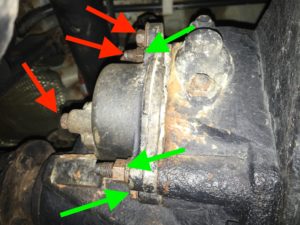
To begin, look at the image above. This photo is taken from the driver’s side of the car. You can see the profile of the e-locker actuator without its protective cover. To remove the cover, loosen the three bolts marked in red. To remove the e-locker motor, follow with the three in green. The left-most arrow is a simple bolt threaded into the axle housing but the two right-most green arrows are actually studs. If the bolt is rusted, the entire stud will pull out. If the differential is full of oil, that oil will end up on your garage floor if the stud pulls out. Make sure to drain your differential oil if the stud if pulling out and you don’t want a mess.
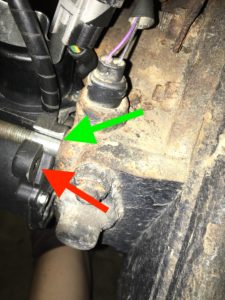
Above is the same view from the top. Note the stud in green (the differential oil sit below the level of this top stud) and where the cover fastens in red. You can also see the three connectors involved with the e-locker actuator–vacuum hose, two-wire status, and six-wire controller.
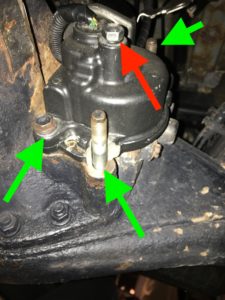
And the bottom with the same fasteners marked.
After pulling the motor off, I planned on opening it up, greasing the gears and cleaning the brushes, reinstalling, and getting on my way. I would not be so lucky.
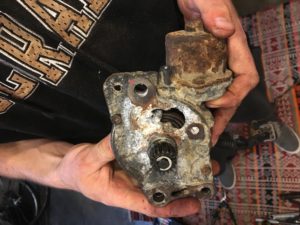
The motor was corroded beyond all recognition. The housing had acquired an unorthodox venting system and the shaft was totally seized. This motor was not coming back from the grave.
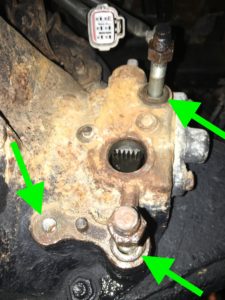
The axle housing wasn’t in much better shape. Note the three bolts and three pins that align the motor as it is tightened. The teeth visible inside the housing slide back and forth to lock and unlock the differential. At this point, we had the car on jack stands and were having all kinds of fun engaging and disengaging various 4WD-related systems to see how they all worked.
Before starting this project, I searched far and wide for a repair manual and came up short. Now that I needed a part, I hunted for a parts catalog. Nothing. A handful of dealerships posted their generic 4Runner parts catalogs online, but none of the rear axle assembly pages showed this motor. I called the parts departments of several local dealerships and never was able to talk to a human or get my phone call returned. Part of this is due to the utter impersonal anonymity of the Bay Area, but I suspect part of it is due to the fact that dealerships only keep parts departments as required by law. The 4Runner forums mentioned that dealers can order a new motor, but the $900, the lead time, and the requirement that I actually got hold of one seemed like insurmountable barriers.
Instead, we found a 5th-gen 4Runner e-locker actuator motor on eBay that would ship out in two days for $250. Perfect! What could go wrong?
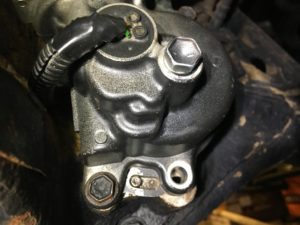
This. Can you tell what the problem is?
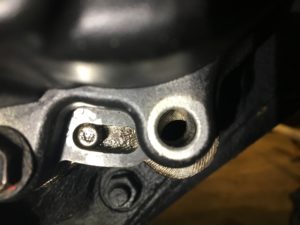
How about now? Somewhere in the 2010-2018 5th-gen 4Runner run, Toyota moved the female threads in the axle housing north 3 mm. I couldn’t believe this. Not only was Toyota sourcing cheapo e-locker actuators that were obviously failing on 4Runners everywhere, but they switched suppliers midrun and made this infuriating change on their customers. The mating surface, the pins, and one out of the three fasteners are all the same, but two of them moved by the length of a long fingernail.
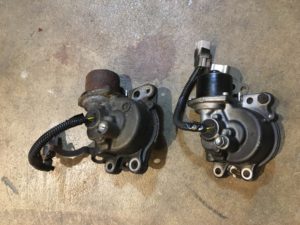
Furthermore, the motors look exactly the same. It took a few minutes of inspection to realize the only difference between the old motor and the new is the raised circle just right of the electrical connector. This wouldn’t have been a huge deal, but we couldn’t refill the differential oil without replacing the e-locker motor and I needed to drive the car. I had to get the new motor on that night. Time to put the thinking cap on.
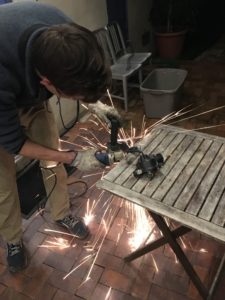
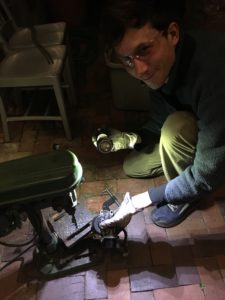
Fortunately, my infinitely patient friend with whom I was performing this automotive surgery was handy with the steel. We bored the holes out on the new motor and ground down the metal that interfered with the pins. A few short hours later, the new e-locked motor was mounted and clicking the differential in and out like a Kentucky bluegrass band.
I would have loved for the story to end here, but the differential was still half-empty and we discovered that the fill plug was seized. After subsequent rounds of prayer, heating with a propane torch, PB Blaster (this stuff is amazing), and a two-foot-long 15/16 six-sided box wrench (the bolt is sized as a 24 mm, 15/16 is 23.8 mm and fits very snugly), the fill plug loosened. While waiting for the differential oil to drain completely, I ran to an auto parts store to pick up new copper crush washers and fill and drain plugs. You guessed it. Along with repair manuals being discontinued, auto parts stores no longer sell auto parts. They couldn’t even order new drain plugs, which are shared across all Toyotas, and recommended going through the dealership. As far as I can tell, auto parts stores stay in business these days by selling cheetah print steering wheel covers and fantastical chemicals that make your car go vroom.
What was the point of writing this long ranting post? For one, I wanted to share some pictures and descriptions explaining how to replace this e-locker motor because there really weren’t any good resources online.
Second, I wanted to comment on the state of DIY in the world. While not everyone needs to be able to rebuild the top end of an engine, plant a victory garden, or move an electrical socket from one side of the room to another, I would love for society to provide anyone with enough interest the tools to follow their curiosity. As the RadioShacks of the world replace their drawers of transistors with cheap cell phones, the Autozones their repair manuals with scented Christmas trees, and the Home Depots their fasteners aisles with a few bubbles of prepackaged M4 and M5 bolts, how will we stay creative as humans? Software is certainly one amazing outlet around here, but how can we work with our hands? I admire the work that my former boss Chris Anderson has put into nurturing the DIYDrones and now DIYRobocars communities. I admire the work that the mentors for the Richmond High School Robotics Club put into getting kids interested in building. I admire all the makers out there and hope that you can keep creating in the era of leave-it-to-a-professional.